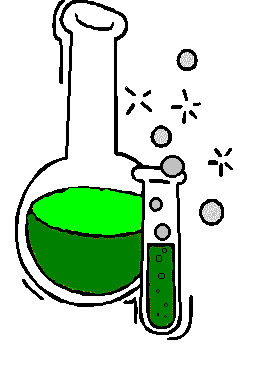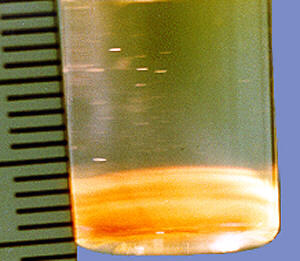Dr. Jimmy Mills' Current
Research Projects

BACK TO
MILLS
HOMEPAGE

RECENT
PUBLICATIONS

RESEARCH
GROUP

AUBURN
UNIVERSITY

CHEMISTRY
DEPARTMENT

Table of Contents
Click on a title to learn more about it:
Photocatalytic Reduction of CFC 11 in an Aqueous Suspension of TiO2
Formation of Gold Colloids in Polymer Gels and Glass Matrices
Formation of Metal Crystallites by Reaction of Au(III) with NADH
Mechanism for Ag Particle Growth in Photographic Emulsions
Photocatalytic Reduction of CFC 11 in an Aqueous
Suspension of TiO2
Illuminated TiO2 suspensions are receiving attention for their catalytic ability to destroy organic pollutants such as chlorofluorocarbons (CFCs). Chlorofluorocarbons contribute to the destruction of the ozone layer and are being replaced by hydrochlorofluorocarbons (HCFCs) which pose less of an environmental threat. A common commercial CFC is trichlorofluoromethane (CFC 11) which is used in refrigeration systems and as a blowing agent in foam manufacturing. An efficient means is needed to destroy unused CFC 11.
Our present research has found that CFC 11 can be photoreduced in an aqueous suspension of titanium dioxide illuminated with near UV light. The CFC is converted to HCFC 21. Formate ions serve as the electron donors in the radical chain mechanism. High photonic efficiencies can be obtained by varying light intensity, solution pH, ionic strength, and species adsorbed on the semiconductor surface.
Photoadaptive Textile Fibers
Research in this area focuses on developing fibers that show high optical and heat reflectivity when exposed to light of sufficient energy and intensity. Changes in properties are caused by the growth of small metal particles. The reverse process causes the fiber to return to its original state. The first step in this reaction, the growth of metal particles in the fiber, is currently being studied. This research could lead to the development of a flexible material that acts as a shield against electromagnetic radiation.
We prepare the fibers by using dimethylsulfoxide to crosslink poly(vinylalcohol) oligomers. Silver (I) ions and AuCl4- ions become incorporated into the fibers by swelling the polymer in methanolic solutions of the metal ions. The fibers are dried, then illuminated by high intensity artificial light or direct sunlight. Silver and gold nanoparticles form during the irradiation. However, ambient light causes no such change. The reverse reaction does not occur. These materials show interesting optical properties due to the growth of the metal particles.

Formation of Gold Colloids in Polymer
Gels and Glass Matrices
I. Reversible Formation of Au Nanoparticles in DADMAC Gels
Click on the image above to see a photo of gold particles within the gel. The polymer is prepared by swelling diallyldimethylammonium chloride (DADMAC) polymer in a methanolic solution containing Au (III). The polymer had previously crosslinked during gramma irradiation. Formation of gold particles is a two-step process. The yellow gel is bleached when illuminated at 350 nm due to the absorption of UV light by the gold cations. During irradiation, the solvent reduces the Au (III) to Au(I), which is colorless. This reaction is easily monitored with a UV/vis spectrophotometer. Continued illumination at 350 nm causes the further reduction of Au (I) to form red Au nanoparticles, similar to those in the picture. The formation of Au (I) from Au (III) is a chain reaction and the second step is a biphotonic process. Both steps followed zero-order kinetics.
In the absence of light, the gold nanoparticles are oxidized back to Au (III). The oxidation also occurs in two stages. The first and second steps take approximately 48 hours and 14 days, respectively.
II. Formation of Au Nanoparticles in Vycor Glass
Vycor glass contains microchannels measuring approximately 40 angstroms in diameter. Non-linear optical effects might be observed when metallic gold nanoparticles are incorporated into the microchannels. In our research, the Vycor glass is doped with Au(III), and then irradiated with UV light. Gold particles begin to form immediately and their growth can be monitored as the color changes from yellow to dark blue. The optical spectrum shows that as the color changes, the plasmon resonance band increases above 500 nm. This suggests that gold particles are being formed. The reverse reaction (oxidation of gold particles) has not been observed yet.
Formation of Metal Crystallites
by Reaction of Au(III) with NADH
Small gold particles can be generated by reacting AuCl4- ions with compounds such as alcohols and polymers. The high reactivity of the Au complexes toward these rather inert compounds suggested possible reactivity patterns that may explain the high toxicity of Au complexes used in the treatment of arthritis. It should be noted that the chemical origins of the toxicity have not been elucidated.
The present investigation focuses on the reaction of AuCl4- with NADH (nicotinamide adenine dinucleotide), which is an important biological reducing agent involved in electron transfer processes during cellular respiration. Nicotinamide mononucleotide (NMNH) is used in order to determine if it reduces and/or stabilizes the gold.
Our goals are to:
- attempt to make small, stable Au particles using NADH as a reducing agent and, perhaps, NAD+ as a particle stabilizer.
- investigate the reaction mechanism of the particle formation process.
- find out if NADH is damaged by AuCl4- during the redox process as such an event may explain, in part, the high toxicity of Au(III) complexes.
Mechanism for Ag Particle Growth
in Photographic Emulsions
A new mechanism shows how silver particles form in black and white photographic emulsions during development. Development begins with the formation of silver clusters which oxidize the developing agent on the silver halide grain surface. The key step in this mechanism occurs when the electrons are transferred from the silver clusters and become delocalized in the silver halide lattice. These delocalized electrons reduce silver cations anywhere on the grain surface. This produces more small silver particles which can continue to oxidize more developing agent and then reduce more silver cations, making the process autocatalytic. Our model, which was tested using optical density spectra previously published by T. H. James, D. Shiao and others, shows that our autocatalytic mechanism fits the data much better than other mechanisms.
| If this type of research interests you, visit these web sites to learn about other chemistry and materials research groups at Auburn: | |
| Rik Blumenthal | Thomas Albrecht-Schmitt |
| Charles Neely | S. David Worley |
| Curtis Shannon | Vince Cammarata |
|
B. Lewis Slaten,
Department of Consumer Affairs |
|